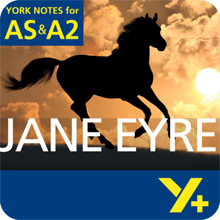Your Assessment
Read through the answer below and decide what grade to give it. Use the Hints & Tips to help you make your assessment.
St John Rivers and Edward Rochester appear to be diametric opposites. Rochester is a dramatic character. He is described as having a strong physical presence – Jane says he has ‘broad and jetty eyebrows, deep eyes, strong features, firm, grim mouth’ and these strong features seem to reflect his strong personality. St John, in contrast, has ‘large and blue’ eyes, a forehead ‘colourless as ivory’ and ‘locks of fair hair’. But St John is often described as being cold and Jane says that he uses his eyes as ‘instruments to search other people’s thoughts’. Rochester later characterises St John as the Greek god of the sun, Apollo, whereas he describes himself as a ‘Vulcan’ – who was the blacksmith to the gods. Educated Victorians would have been very familiar with Classical mythology of this kind.
Rochester is of a higher class, but his family’s greed for money results in his disastrous marriage to Bertha; ‘I never loved, I never esteemed, I did not even know her.’ This agonised repetition emphasises Rochester’s regret. Rochester’s position also requires him to throw society parties and to hide Bertha’s madness, so that he can be seen as a respectable landowner. St John has much lower social status as a clergyman. Brontë says he is ‘zealous’ in his work, but that he does not to appear to ‘enjoy’ it, just as he is uninterested in the ‘thousand peaceful delights’ of the moors. Rochester, in contrast, is a passionate character in all of his emotions.
St John tells Jane: ‘Reason, and not feeling, is my guide’ – the foregrounding of the word ‘reason’ shows us St John’s priorities. This is the opposite to Rochester who is often driven by his emotions – he says to Jane: ‘Disappointment made me reckless’, for example. By contrast, when St John is disappointed by Jane’s refusal to marry him, he continues to behave in exactly the same way as ever, which to Jane is evidence of a ‘corrupt’ side to him that can behave so dishonestly for a Christian man. Here Brontë explores the link between religion and oppression, just as she does in the episodes at Lowood School. This presentation of religious hypocrisy can also be seen in in Charles Dickens’s Mr Pumblechook, for example, who is cruel to Pip while quoting the Bible at him.
A psychoanalytical reading of the two characters could suggest that they symbolise different sides to Jane. St John symbolises the side of Jane that could have withdrawn from the world, especially after discovering Rochester’s marriage. He also symbolises the side of Jane that embraces rules and is self denying. Rochester, in contrast, could be seen as the subconscious side to Jane – or the id – that is emotional and free spirited. Jane and Rochester often talk to each other in terms of spirits and the supernatural, whereas Jane and St John mainly talk about duty and the Bible. Even when Jane turns down his proposal, St John says ‘it is not me you deny, but God’.
